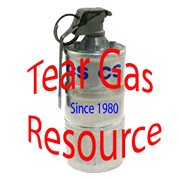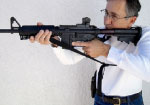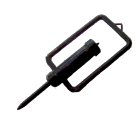Pepper spray is derived from the same things you find in hot sauce but at much higher concentrations. The question is what makes pepper spray (OC) hot?

Pepper Spray contains a hot pepper extract called oleoresin capsicum or OC, but the OC itself is not the actual active ingredient. Rather, the OC contains specific chemical compounds called  capsaicinoids and these capsaicinoids actually produce the desired effects. The only true statement and rating of hotness in a pepper spray is the Major Capsaiciniods (MC) rating. Without knowing what the MC percentage is, you do not know the strength of the pepper spray. The Famous OC percentages and Scoville Heat Units (SHU) tell you nothing about the hotness of a particular spray! Click here to see a list of SHU for most peppers. Although the use of pepper spray is widespread in the United States by law enforcement, U.S. troops fighting overseas are banned from using it in combat by international treaty. The UN Chemical Weapons Treaty treats it as a war gas and inhumane to use in combat. The Food and Drug Administration regulates its use against animals. In most jurisdictions no one regulates its use against humans.
capsaicinoids and these capsaicinoids actually produce the desired effects. The only true statement and rating of hotness in a pepper spray is the Major Capsaiciniods (MC) rating. Without knowing what the MC percentage is, you do not know the strength of the pepper spray. The Famous OC percentages and Scoville Heat Units (SHU) tell you nothing about the hotness of a particular spray! Click here to see a list of SHU for most peppers. Although the use of pepper spray is widespread in the United States by law enforcement, U.S. troops fighting overseas are banned from using it in combat by international treaty. The UN Chemical Weapons Treaty treats it as a war gas and inhumane to use in combat. The Food and Drug Administration regulates its use against animals. In most jurisdictions no one regulates its use against humans.
Dr. Richard Clark, director of the Division of Toxicology at the University of California, San Diego Medical Center, says that most effects of pepper spray are short-lived, although they could have a stronger effect on people with asthma or other pre-existing respiratory conditions. He said pepper spray acts by stimulating pain centers. It causes your eyes to shut and makes breathing difficult. It can cause coughing and choking, and a severe burning sensation on your face. But it is temporary; usually it lasts from 30 to 45 minutes.
Hot peppers and derivative products such as pepper (capsicum) extracts and sprays are comprised of a family of 5 heat producing compounds called capsaicinoids. These 5 compounds have different biochemical and physiological characteristics and very different degrees of pungent sensation effects on the body. Capsaicin is the main capsaicinoid in chili peppers, followed by dihydrocapsaicin. These two compounds are also about twice as potent to the taste and nerves as the minor capsaicinoids, nordihydrocapsaicin, homodihydrocapsaicin, and homocapsaicin.
When the skin or other parts of the body comes in contact with capsaicinoids, nerve endings responsible for the sensations of heat, cold and pain are stimulated. The chemical interaction of the capsaicinoids with these nerve endings makes the body "think" that a "localized heat source" has been encountered. The affected area becomes flush with blood rising to the area to provide cooling, and the subject may sweat profusely. The burning sensation can last several hours to several days if left untreated. It's odorless, colorless, and even flavorless, but just one milligram (about 0.00003 ounces) of pure capsaicin is enough to cause blisters to form on your skin.
becomes flush with blood rising to the area to provide cooling, and the subject may sweat profusely. The burning sensation can last several hours to several days if left untreated. It's odorless, colorless, and even flavorless, but just one milligram (about 0.00003 ounces) of pure capsaicin is enough to cause blisters to form on your skin.
Capsaicin (C) and Dihydrocapsaicin (DHC) are the major "heat" components of pepper extract (typically amounting to 80% to 90% of capsaicinoids present). Nordihydrocapsaicin (NDHC) typically makes up less than 10% of the total capsaicinoids mix. It is the most polar and thus least "tissue soluble" of the capsaicinoids. It has a very sharp peppery pungency and is the component that gives the stinging sensation. Homocapsaicin (HC) and Homodihydrocapsaicin (HDHC) total about 2% by weight and 5% of the total pungency.
Besides the five natural capsaicinoids, one synthetic member of the capsaicinoid family exists. Vanillylamide of n-nonanoic acid (VNA, also PAVA) is used as a reference substance for determining the relative pungency of capsaicinoids. Some companies are using PAVA as the active ingredient in their sprays. Other companies use PAVA to ensure their products reach the MC level they advertise.

You can measure the level of capsacianoids present using high performance liquid chromatography (HPLC). Products range from 0 .18% to 3.00% capsacianoids by weight. Bear sprays typically range from 1.00% -2.00%.
It’s difficult to objectively assess the exact real-world relationship between hotness and effectiveness because there are a lot of other variables involved. Variables include the sobriety level of the suspect. Is he stoned, drunk, enraged, or mentally ill? Does he feel pain? How long will it take him to recover? All these play a part in the right choice of your chemical spray. Do not fall into the trap that the hotter it is the more effective it is. Approximately 14% of the population may not be affected by the spray as evidenced by statistics captured in a California government study.





